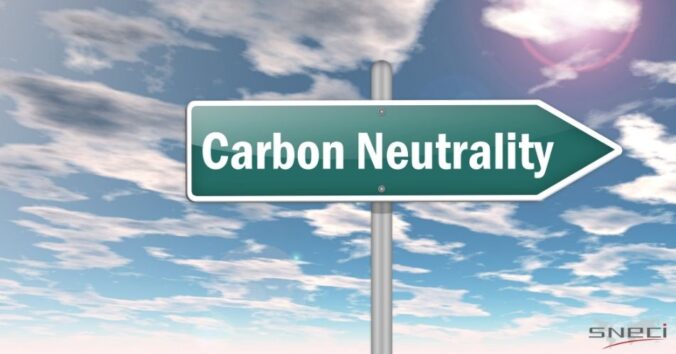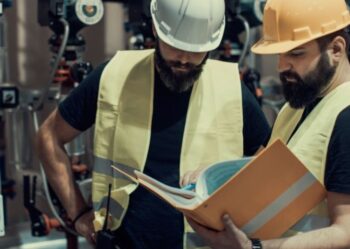Decarbonization or how to reduce its carbon footprint

The decarbonization of industry offers manufacturers the opportunity to improve their performance, but above all to achieve CO2 neutrality.
The goal is simple. Contribute to company profits by saving energy or by better controlling dependence on fossil fuels for today’s economy and environment.
Let’s see how to develop an action plan to improve energy efficiency.
Décarbonation or decarbonization definition :
Decarbonation (or decarbonization) refers to all the measures and techniques put in place to limit the carbon footprint. In English, there are two terms: decarbonation and decarbonization and therefore we also find them in French: décarbonation et décarbonisation. The Petit Larousse suggests the term decarbonation. However, it seems to refer to the “elimination of calcium and magnesium acid carbonates by adding lime”. Between the use of decarbonation and decarbonization, the French Academy has not yet decided, unlike the Official Journal in 2019: the use of decarbonation is the rule.
Under the word decarbonization, we find all the measures by which actors (countries, companies, sectors of activity or economy) can reduce their carbon footprint, that is to say the emissions of greenhouse gases, (mainly carbon dioxide (CO2) and methane (CH4) in order to limit their climate impact.
Decarbonation is mainly achieved by replacing hydrocarbons with “clean” energy sources that are not associated with greenhouse gas emissions. Therefore, renewable energy sources (solar, wind, geothermal, biomass, etc.) or non-carbon energy sources (nuclear) are favored.
Different solutions exist in order to decarbonize the industry that we will see together.
Hydrogen allows the decarbonation of the Industry
To achieve the pace and magnitude of emissions reductions projected in the Net Zero Emission by 2050 scenario, a comprehensive set of actions beyond the already ambitious measures of the SDS scenario would be required.
In all sectors of activity, a combination of decarbonization and energy efficiency actions should be implemented. Thus, the electrification of the manufacturing process and the use of low-carbon hydrogen are where investments should be increased.
To launch solutions in French cities by 2030-2040 and ensure participation in the development of the competitive sector, it is essential to improve electrolysis and storage technologies and develop uses, particularly for mobility.
In today’s industry, hydrogen is mainly used for non-energy purposes as a “material” in technological processes, although there is an energy use for the production of heat or, to a certain extent, electricity.
If all steel produced in France currently was using green hydrogen, the electricity consumption to reduce iron ore production would be about 35 TWh per year, or about 7% of France’s current electricity consumption.
Thus, in the context of decarbonization, green hydrogen cannot be the only solution to replace grey hydrogen in the steel or chemical industries, except for significant investments in power generation facilities.
By 2035, several actions need to be put in place to prepare for the development and implementation of technologies that convert electricity from renewable sources into gas.
-
Hydrogen at the European scale :
The European Union (EU) has developed an ambitious vision for the integration of hydrogen into energy systems and many industrial sectors with two draft strategies each adopted by the European Commission on July 8, 2020, on energy system integration and hydrogen for a climate neutral Europe, respectively.
Europe is also very competitive in clean hydrogen technology and is well positioned to benefit from the development of pure hydrogen worldwide.
Cumulative investments in renewable hydrogen in Europe could range from €180 billion to €470 billion by 2050 and from €3 billion to €18 billion for low fossil carbon hydrogen.
Analysts estimate that by 2050, pure hydrogen could meet 24% of the world’s energy demand with an annual turnover of around €630 billion.
Almost all Member States have included pure hydrogen initiatives in their national energy and climate plans, 26 have participated in hydrogen initiatives and 14 have integrated hydrogen into their national alternative fuel infrastructure deployment frameworks.
The investment cycle in the clean energy sector is about 25 years, so it’s time to act. At the same time, this roadmap complements the presented energy system integration strategy, which describes how the different work areas of EU energy policy, in particular the development of hydrogen, will contribute to the creation of an integrated climate-neutral energy system. It is based on renewable electricity, closed cycle, renewable and low carbon fuels.
-
Decarbonated hydrogen produced by electrolysis
Due mainly to industrial processes that require high purity hydrogen, water electrolysis produces only 0.1 to 70 Mt of hydrogen per year worldwide.
Hydrogen produced by water electrolysis is called “green” hydrogen when it comes from renewable energies, and “yellow” when it comes from nuclear power (hydrogen produced from nuclear power).
Interest in water electrolysis for hydrogen production is growing for several reasons.
- If the electricity used is low carbon (based on nuclear, renewable or fossil fuels but with CCUS), it is a low CO2 emission production.
- The price of the electrolytic cell tends to go down,
- The cost of energy storage, for example with batteries, remains high.
- The rapid development of EnRi12 creates random power surges.
According to the IEA, about 50 kWh of electricity and 9 liters of water are needed to produce 1 kg of hydrogen by electrolysis.
There are currently two electrolyzer technologies dividing the market, and a third is beginning to emerge.
- Alkaline electrolysis, the most extensive and proven technology (in existence since the 1920s), but in relative decline,
- Proton Exchange Membrane (PEM) electrolyzers – a rapidly evolving technology;
- High temperature SOEC (solid oxide electrolyzers) under development.
- Gas reforming as a current source of carbon-free hydrogen
Today, over 95% of hydrogen is still produced from fossil fuels, using 6% of the world’s natural gas production and 2% of the world’s coal production.
Most hydrogen production comes from steam reforming of natural gas (or other hydrocarbons such as ethanol, propane or gasoline), called SMR (SteamMethane Reforming), or to a lesser extent, ATR (Autothermal Reforming), both of which require large facilities and high CO2 emissions.
The methane used upstream in these hydrogen production processes can be either natural gas, in which case it is referred to as “grey” hydrogen, or gasified coal, in which case it is referred to as “black” or “brown” hydrogen. After all, various studies have shown that hydrogen produced by SMR with CCUS (Carbon Capture, Utilization, and Storage) costs between 2 and 2.5 €/kg in Europe due to higher gas prices than in other parts of the world where the cost can go up to 1.5-2. €/kg.
CO2 capture, storage and use
To achieve carbon neutrality by 2070, the IEA expects to significantly increase its annual CO2 capture and storage capacity.
For France, the DGEC estimates that the role of CCS will be essentially limited to reducing residual emissions from industrial processes and generating negative emissions from biomass combustion.
CCS should not cover the CO2 emissions from fossil fuels in France.
This may not seem like much, but electricity in France is already very low-carbon and access from France is expensive because several geological storage facilities are under construction in Europe and the North Sea.
Capture technologies with different maturities
There are three types of processes to separate CO2 from the other components of the flue gas (steam, nitrogen dioxide, etc.):
– Post-combustion: the separation of CO2 takes place at the outlet of the industrial plant by means of processes such as absorption in solvents (usually amines), absorption in solids, absorption in membrane diffusion or frozen distillation.
– Pre-combustion: fuel that is combined with steam or oxygen to produce syngas, which includes CO and H2. The reaction of CO with steam leads to additional H2 production and the conversion of CO to CO2. By separating the CO2 from the gas mixture at high pressure, a gas suitable for energy production is obtained
– Oxycombustion: the combustion oxygen is separated from the nitrogen in the air by freeze distillation, membrane separation or chemical looping (supply of oxygen in the form of metal oxide). Combustion is carried out with almost pure oxygen producing a combustible gas composed almost entirely of CO2 and water vapor, which can be easily separated by condensation.
CO2 valorization as a complement
According to an IEA27 report, 230 million tons of CO2 per year worldwide is used primarily for fertilizer (130 million tons of CO2/year).
Other commercial uses include CO2 (20 Mt/yr): food production (including soft drinks), metal manufacturing, refrigeration, and plant growth promotion in greenhouses.
The IEA identifies five major products that may represent an initial market of 10 MtCO2/yr for each.
- Fuels produced from CO2 such as methane, methanol and syngas can be produced with hydrogen. It can be particularly attractive in aviation as a replacement for pure hydrogen.
- CO2 chemicals can be formed from methanol: olefins, polymers, aromatics, etc. Polycarbonate production from CO2 appears to be competitive in the current market due to its low energy consumption and high market value.
- Cement is a potential CO2 sink due to the presence of calcium silicate, which can react with CO2 to form calcium carbonate.
- Building materials can be made from CO2 and waste materials (iron slag, coal fly ash, bauxite residue, etc.).
- CO2-induced increases in crop yields (algae production, greenhouse crops, etc.) can be significant up to 25-30%. The IEA estimates that CO2 consumption will be between 250 and 878 Mt CO2 per year in 2060. Consequently, the mass of CO2 used in the world should only represent a few percent of the mass stored in geological structures.
SNECI and the accompaniment towards the decarbonized production of industrials
We support our customers in the decarbonization of their industry and production by improving their processes and profitability while taking into account environmental and local regulatory constraints.
Our 10 subsidiaries allow us to support any industrial or supplier worldwide, whether in Africa, Asia, Europe or America.
Our support in decarbonizing industrial production is based on several axes:
- Defining a strategy adapted to your ambitions with clear objectives aligned with your agenda
- Robustly measuring the impact of your activity on climate change
- Establishing a roadmap and an action plan to reduce your greenhouse gas emissions that integrates numerous levers adapted to your activity
- Offset your residual emissions within the scope you have defined
Our commitment to the fight against climate change covers many other issues with various co-benefits thanks to our ISA assessment tool which allows us to take into account the following aspects
- Your contribution to the restoration of biodiversity
- The sustainable management of water resources,
- The value of your actions to your employees, your customers and your financiers,
- Guarantee the sustainability of your activity and your company.
You wish to be called back by one of our experts, contact us!






